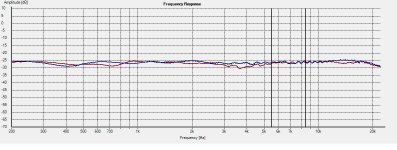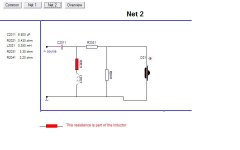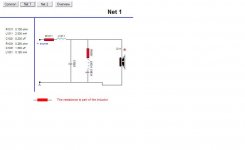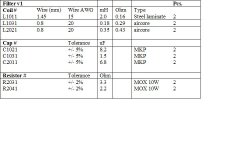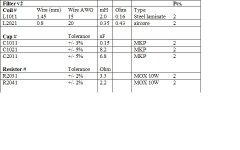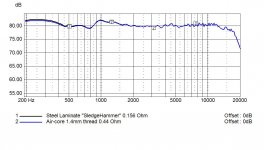System measurements:
Continued…
Picture1: Tweeter-axis, 30 degrees system.
Picture2: Tweeter-axis, 30 degrees system + individual drivers.
Picture3: Tweeter-axis, 30 degrees system, tweeter inverted polarity.
Picture4: Tweeter-axis, 45 degrees system.
Picture5: Tweeter-axis, 45 degrees system + individual drivers.
Picture6: Tweeter-axis, 45 degrees system, tweeter inverted polarity.
Picture7: Tweeter-axis, 30 degrees system + smoothing
Picture8: Tweeter-axis, 30 degrees system + individual drivers + smoothing.
Picture9: Tweeter-axis, 15-45 degrees system overlay.
Comments:
• Picture1-6+9. Frequency plot is shown with an 80db scale and without smoothing.
• Picture7-8. Frequency plot is shown with an 80db scale and with 1/12 octave smoothing.
• Picture9. Nice power response. System optimized for 15-30 degrees listening angle.
• Frequency measurements are valid down to approx. 250Hz.
Summing up: The measured response looks just like the simulated. The individual driver unit phase tracking are just as excellent as the simulated.
Next, listening impressions……….
Continued…
Picture1: Tweeter-axis, 30 degrees system.
Picture2: Tweeter-axis, 30 degrees system + individual drivers.
Picture3: Tweeter-axis, 30 degrees system, tweeter inverted polarity.
Picture4: Tweeter-axis, 45 degrees system.
Picture5: Tweeter-axis, 45 degrees system + individual drivers.
Picture6: Tweeter-axis, 45 degrees system, tweeter inverted polarity.
Picture7: Tweeter-axis, 30 degrees system + smoothing
Picture8: Tweeter-axis, 30 degrees system + individual drivers + smoothing.
Picture9: Tweeter-axis, 15-45 degrees system overlay.
Comments:
• Picture1-6+9. Frequency plot is shown with an 80db scale and without smoothing.
• Picture7-8. Frequency plot is shown with an 80db scale and with 1/12 octave smoothing.
• Picture9. Nice power response. System optimized for 15-30 degrees listening angle.
• Frequency measurements are valid down to approx. 250Hz.
Summing up: The measured response looks just like the simulated. The individual driver unit phase tracking are just as excellent as the simulated.
Next, listening impressions……….
Attachments
-
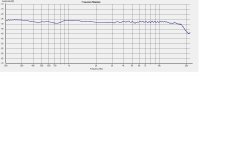 Picture1.JPG106.7 KB · Views: 488
Picture1.JPG106.7 KB · Views: 488 -
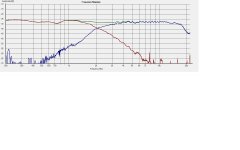 Picture2.JPG116.4 KB · Views: 478
Picture2.JPG116.4 KB · Views: 478 -
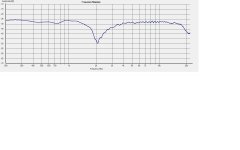 Picture3.JPG107.4 KB · Views: 468
Picture3.JPG107.4 KB · Views: 468 -
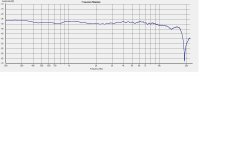 Picture4.JPG107.7 KB · Views: 460
Picture4.JPG107.7 KB · Views: 460 -
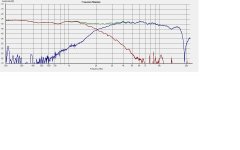 Picture5.JPG118.8 KB · Views: 456
Picture5.JPG118.8 KB · Views: 456 -
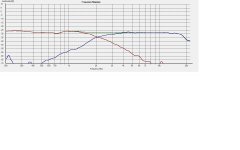 Picture8.JPG125.3 KB · Views: 59
Picture8.JPG125.3 KB · Views: 59 -
 Picture7.JPG120.5 KB · Views: 59
Picture7.JPG120.5 KB · Views: 59 -
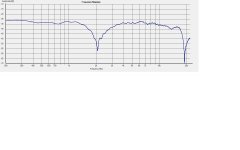 Picture6.JPG108.4 KB · Views: 62
Picture6.JPG108.4 KB · Views: 62 -
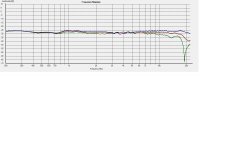 Picture9.JPG126 KB · Views: 73
Picture9.JPG126 KB · Views: 73
Listening impressions:
Ok, it’s time for – how does it sound? 😀
As I said in the first post I would compare my speaker against a much known DIY design.
Here it is:
Zaph Audio SR71
The SR71 is a very solid well engineered speaker using proven speaker units. I think Mr Krutke has done a nice job with this design. It’s easier for me to benchmark and describe my new design to the readers, by using a known design used by many people.
First, I will describe how I have implemented the SR71 design and show my own measurements of the speaker.
• Enclosure: Parts Express “302-721s”, 14 liter curved cabinet.
• The baffle backside is chamfered for the woofer.
• SEAS ER18RNX (H1456) and 27TDFC (H1189) driver units.
• 2” port tuned to 44Hz.
• I used Zaphs original filter without any modifications.
• Sledgehammer Steel Laminate and air-core inductors.
• Clarity SA and PX caps.
• Supra PLY for internal wiring.
Picture1: SAL451 and SR71 side by side.
Picture2: Cross-over schematics.
Picture3: Impedance plot.
Picture4: Tweeter-axis, 0 degrees system + individual drivers.
Picture5: Tweeter-axis, 0 degrees system, tweeter inverted polarity.
Picture6: Tweeter-axis, 15 degrees system + individual drivers.
Picture7: Tweeter-axis, 15 degrees system, tweeter inverted polarity.
Picture8: Tweeter-axis, 0 degrees system, left (blue) and right (red) speaker.
Picture9: Tweeter-axis, 15 degrees system, left (blue) and right (red) speaker.
Picture10: Tweeter-axis, 0 degrees (blue) and 15 degrees (red) system overlay.
Looks good, nothing strange going on here and the speaker seems to conform to the original design. 🙂
Next, listening impressions continued……….
Ok, it’s time for – how does it sound? 😀
As I said in the first post I would compare my speaker against a much known DIY design.
Here it is:
Zaph Audio SR71
The SR71 is a very solid well engineered speaker using proven speaker units. I think Mr Krutke has done a nice job with this design. It’s easier for me to benchmark and describe my new design to the readers, by using a known design used by many people.
First, I will describe how I have implemented the SR71 design and show my own measurements of the speaker.
• Enclosure: Parts Express “302-721s”, 14 liter curved cabinet.
• The baffle backside is chamfered for the woofer.
• SEAS ER18RNX (H1456) and 27TDFC (H1189) driver units.
• 2” port tuned to 44Hz.
• I used Zaphs original filter without any modifications.
• Sledgehammer Steel Laminate and air-core inductors.
• Clarity SA and PX caps.
• Supra PLY for internal wiring.
Picture1: SAL451 and SR71 side by side.
Picture2: Cross-over schematics.
Picture3: Impedance plot.
Picture4: Tweeter-axis, 0 degrees system + individual drivers.
Picture5: Tweeter-axis, 0 degrees system, tweeter inverted polarity.
Picture6: Tweeter-axis, 15 degrees system + individual drivers.
Picture7: Tweeter-axis, 15 degrees system, tweeter inverted polarity.
Picture8: Tweeter-axis, 0 degrees system, left (blue) and right (red) speaker.
Picture9: Tweeter-axis, 15 degrees system, left (blue) and right (red) speaker.
Picture10: Tweeter-axis, 0 degrees (blue) and 15 degrees (red) system overlay.
Looks good, nothing strange going on here and the speaker seems to conform to the original design. 🙂
Next, listening impressions continued……….
Attachments
-
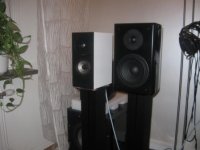 Picture1.JPG21.1 KB · Views: 316
Picture1.JPG21.1 KB · Views: 316 -
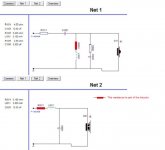 Picture2.JPG31.7 KB · Views: 343
Picture2.JPG31.7 KB · Views: 343 -
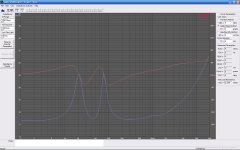 Picture3.JPG171.5 KB · Views: 199
Picture3.JPG171.5 KB · Views: 199 -
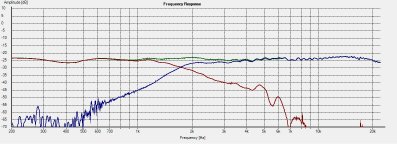 Picture6.JPG116.7 KB · Views: 82
Picture6.JPG116.7 KB · Views: 82 -
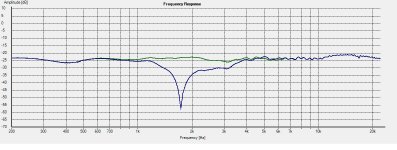 Picture5.JPG110.7 KB · Views: 97
Picture5.JPG110.7 KB · Views: 97 -
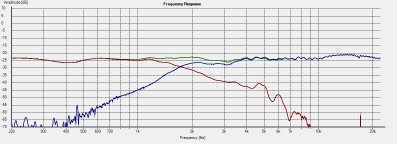 Picture4.JPG116.2 KB · Views: 105
Picture4.JPG116.2 KB · Views: 105 -
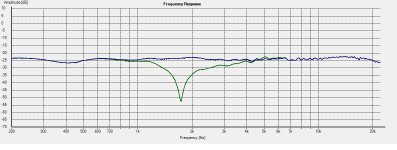 Picture7.JPG110.5 KB · Views: 80
Picture7.JPG110.5 KB · Views: 80 -
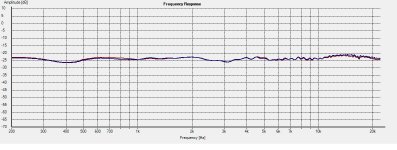 Picture8.JPG109.3 KB · Views: 65
Picture8.JPG109.3 KB · Views: 65 -
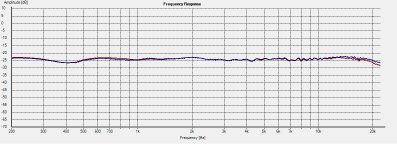 Picture9.JPG109.1 KB · Views: 65
Picture9.JPG109.1 KB · Views: 65 -
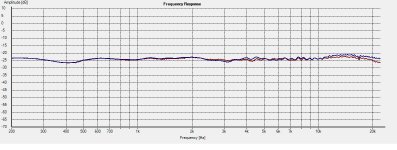 Picture10.JPG109.7 KB · Views: 82
Picture10.JPG109.7 KB · Views: 82
Now the fun begins. This will be interesting, metal vs. well documented low distortion paper. I cannot wait for your comments.
Regards,
Eric
Regards,
Eric
Wow, great thread, nice build Gornir! I'm thinking you're going to need to high pass that SR71 at the -3dB point of your L12s, otherwise listening impressions might lean favorably towards the SR71. 🙂
Listening impressions continued:
Thank you for your comments.
It’s not easy to describe how something sounds, especially to describe it in another language, but I give it a try. 🙂
First, I shortly describe what kind of equipment I’ve used when listening and evaluated the SAL451 and SR71. Since a couple of years ago I have switched to a computer based music listening setup, instead of a CD/DVD transport setup. The computer setup is simply more convenient and it sounds much better in my opinion, if it’s used properly and configured right. All my music is ripped to “flac” lossless format and I listen a lot to high resolution (24bit/96kHz) music through this setup.
Test equipment and connection chain:
1. ASUS EeeBox EB1012 PC running Windows7.
2. Foobar 2000 Media Player with Musiland ASIO drivers (bit perfect setup).
3. Musiland Monitor 01 USD 24/192 USB to SPDIF.
4. Monarchy Audio DIP 48/96 precision clock and upsampler.
5. DEQX HDP-3 Preamp Processor.
6. PopPulse T150 Class-T Amplifier or Chiro C-500 Class-AB Amplifier.
SAL451 sound characteristics:
Besides myself I invited a couple of friends to help me evaluate the SAL451. These guys are not a tech nerd like me and they don’t care about cross-over frequencies and driver units etc. They just love music and wants loudspeakers to reproduce music as natural as possible. They are a great “human” tool for me to get an outside opinion of my design.
This all metal design doesn’t sound metal at all, which should be a relief for all metal-allergic people 🙂 I myself isn’t that fanatic about which cone material to use. It all depends on the design, how you use it and how it sounds.
The sound is more leaning at the warm direction rather than analytical, which is good for my taste. For comparison I think its warmer sounding than the SR71 in the midrange. This could be because of the SR71 is a bit elevated frequency response in that area (see picture1) and the paper cone characteristic.
Picture1: SR71 (blue), SAL451 (red). Tweeter-axis, 15 degrees and no smoothing.
These babies are obviously not for bass-oholics, but they have well defined bass output down to the mid 50;ies in room response. Here the 20Hz lower port tuning of the SR71 makes a clear difference. However when used with a sub-woofer or by applying some EQ in the low-end this evens out and the SAL451 can play great bass for its size.
Imaging, width, height and depth are simply better with the SAL451. The 3D-perspective is great. Sometimes when I close my eyes and listen I can’t really pinpoint the speakers, only hear a wide sound stage floating around. The SR71 playing more to your face so to speak. The differences aren’t huge, but very noticeable.
The highs are crispy and airy with the SAL451 and in comparison, I think the SR71 is a bit grainy in the highs. It’s like seeing through a clean window with the SR71, but with the SAL451 it’s like opening the windows, if you get my point. The SEAS H1212 and the H1189 share the same motor structure, but I think the H1212 is superior and despite its metal cone doesn’t sound harsh or metallic in any way, just more natural to my ears. Both drivers are great value for its price.
Summation of comparison between SAL451 and SR71:
SR71:
+ Higher sensitivity than SAL451.
+ Higher max SPL SAL451.
+ Good imaging.
+ More and deeper low-frequency output than SAL451.
– A bit grainy highs.
– A bit too forward mids.
– Less forgiving on bad recordings.
SAL451:
+ Excellent imaging.
+ Deep and wide sound stage.
+ More 3-Dimensional and warm than SR71.
+ Airy and fluid highs.
– Less deep and powerful low-frequency output than SR71.
– Lower sensitivity and lower max SPL than SR71.
I like both designs in different ways, but for the moment I’m using the SAL451 in my main rig in the living room. I couldn’t convince my wife to have them in the bedroom as planned, anyway. 😛
To sum up, I think the SAL;s are real fun to listen to and I have voiced them a bit with my DEQX pre-amp by applying some EQ in the digital-domain. The main voicing is a small “BBC” dip centered at 2250z -2db with a Q of 0.5. I also applied some EQ in the bass region, when used without a sub-woofer. In this setup they sound like magic too my ears. The SR71 also benefit from this “BBC” setup. The reason for this fine tuning is most likely to my own preferences as well as my setup in the living room and the room interaction.
Mainly, no voicing with the DEQX EQ has been used when comparing the SR71 and the SAL451.
Disclaimer:
The listening impressions and opinions are mine and to some extent my friends. I’m aware that different people have different preferences and taste on how a loudspeaker should sound and reproduce music. The loudspeaker can also sound different when using another equipment setup etc.
When designing a speaker for yourself you have the benefit to build in your own taste of it should sound, rather than using someone else’s design. That said, I doesn’t claim that the SAL451 is a better design than the SR71, just different and suits my preferences better.
You have to judge yourself by looking at the design and perhaps build a set yourself and test it. 🙂
Next, design wrap-up……….
Thank you for your comments.
It’s not easy to describe how something sounds, especially to describe it in another language, but I give it a try. 🙂
First, I shortly describe what kind of equipment I’ve used when listening and evaluated the SAL451 and SR71. Since a couple of years ago I have switched to a computer based music listening setup, instead of a CD/DVD transport setup. The computer setup is simply more convenient and it sounds much better in my opinion, if it’s used properly and configured right. All my music is ripped to “flac” lossless format and I listen a lot to high resolution (24bit/96kHz) music through this setup.
Test equipment and connection chain:
1. ASUS EeeBox EB1012 PC running Windows7.
2. Foobar 2000 Media Player with Musiland ASIO drivers (bit perfect setup).
3. Musiland Monitor 01 USD 24/192 USB to SPDIF.
4. Monarchy Audio DIP 48/96 precision clock and upsampler.
5. DEQX HDP-3 Preamp Processor.
6. PopPulse T150 Class-T Amplifier or Chiro C-500 Class-AB Amplifier.
SAL451 sound characteristics:
Besides myself I invited a couple of friends to help me evaluate the SAL451. These guys are not a tech nerd like me and they don’t care about cross-over frequencies and driver units etc. They just love music and wants loudspeakers to reproduce music as natural as possible. They are a great “human” tool for me to get an outside opinion of my design.
This all metal design doesn’t sound metal at all, which should be a relief for all metal-allergic people 🙂 I myself isn’t that fanatic about which cone material to use. It all depends on the design, how you use it and how it sounds.
The sound is more leaning at the warm direction rather than analytical, which is good for my taste. For comparison I think its warmer sounding than the SR71 in the midrange. This could be because of the SR71 is a bit elevated frequency response in that area (see picture1) and the paper cone characteristic.
Picture1: SR71 (blue), SAL451 (red). Tweeter-axis, 15 degrees and no smoothing.
These babies are obviously not for bass-oholics, but they have well defined bass output down to the mid 50;ies in room response. Here the 20Hz lower port tuning of the SR71 makes a clear difference. However when used with a sub-woofer or by applying some EQ in the low-end this evens out and the SAL451 can play great bass for its size.
Imaging, width, height and depth are simply better with the SAL451. The 3D-perspective is great. Sometimes when I close my eyes and listen I can’t really pinpoint the speakers, only hear a wide sound stage floating around. The SR71 playing more to your face so to speak. The differences aren’t huge, but very noticeable.
The highs are crispy and airy with the SAL451 and in comparison, I think the SR71 is a bit grainy in the highs. It’s like seeing through a clean window with the SR71, but with the SAL451 it’s like opening the windows, if you get my point. The SEAS H1212 and the H1189 share the same motor structure, but I think the H1212 is superior and despite its metal cone doesn’t sound harsh or metallic in any way, just more natural to my ears. Both drivers are great value for its price.
Summation of comparison between SAL451 and SR71:
SR71:
+ Higher sensitivity than SAL451.
+ Higher max SPL SAL451.
+ Good imaging.
+ More and deeper low-frequency output than SAL451.
– A bit grainy highs.
– A bit too forward mids.
– Less forgiving on bad recordings.
SAL451:
+ Excellent imaging.
+ Deep and wide sound stage.
+ More 3-Dimensional and warm than SR71.
+ Airy and fluid highs.
– Less deep and powerful low-frequency output than SR71.
– Lower sensitivity and lower max SPL than SR71.
I like both designs in different ways, but for the moment I’m using the SAL451 in my main rig in the living room. I couldn’t convince my wife to have them in the bedroom as planned, anyway. 😛
To sum up, I think the SAL;s are real fun to listen to and I have voiced them a bit with my DEQX pre-amp by applying some EQ in the digital-domain. The main voicing is a small “BBC” dip centered at 2250z -2db with a Q of 0.5. I also applied some EQ in the bass region, when used without a sub-woofer. In this setup they sound like magic too my ears. The SR71 also benefit from this “BBC” setup. The reason for this fine tuning is most likely to my own preferences as well as my setup in the living room and the room interaction.
Mainly, no voicing with the DEQX EQ has been used when comparing the SR71 and the SAL451.
Disclaimer:
The listening impressions and opinions are mine and to some extent my friends. I’m aware that different people have different preferences and taste on how a loudspeaker should sound and reproduce music. The loudspeaker can also sound different when using another equipment setup etc.
When designing a speaker for yourself you have the benefit to build in your own taste of it should sound, rather than using someone else’s design. That said, I doesn’t claim that the SAL451 is a better design than the SR71, just different and suits my preferences better.
You have to judge yourself by looking at the design and perhaps build a set yourself and test it. 🙂
Next, design wrap-up……….
Attachments
Wow, very nice job Gornir. You did very well conveying what you were hearing, and I think you made a very fair comparison. Thanks for putting such effort into this!
Thanks Xyrium for your nice comments.
I think both designs are good and I have tried to be as objective as I can in my description.
There is something with the midrange I don’t like with the SR71, something analytical. I haven’t tested the ER15 and perhaps it shares the same characteristic? Otherwise it would be fun to test the same drivers in a small 3-way with one or two ER18 as woofer and the ER15 as mid and the H1212 or H1189 as tweeter. I think the ER18 is more suitable as woofer and with a bit larger box volume than the 14 litres used in the SR71.
Perhaps I will someday make my own design with the L18 and H1212 and compare it with the SR71, which would be a more fair comparison in size and low-end extension. Metal versus paper/fabric. I’m also interested to test Mark K:s design with the ER18 and the SEAS DXT tweeter. It’s most likely the next reference design I would build, because I already have all the necessary driver units and components.
The problem is that I have too many designs running in my head at the moment. 😛
Regards
/Goran
I think both designs are good and I have tried to be as objective as I can in my description.
There is something with the midrange I don’t like with the SR71, something analytical. I haven’t tested the ER15 and perhaps it shares the same characteristic? Otherwise it would be fun to test the same drivers in a small 3-way with one or two ER18 as woofer and the ER15 as mid and the H1212 or H1189 as tweeter. I think the ER18 is more suitable as woofer and with a bit larger box volume than the 14 litres used in the SR71.
Perhaps I will someday make my own design with the L18 and H1212 and compare it with the SR71, which would be a more fair comparison in size and low-end extension. Metal versus paper/fabric. I’m also interested to test Mark K:s design with the ER18 and the SEAS DXT tweeter. It’s most likely the next reference design I would build, because I already have all the necessary driver units and components.
The problem is that I have too many designs running in my head at the moment. 😛
Regards
/Goran
H Gornir,
Thank you for the build information that you have provided. I have enjoyed your excellent effort. Could you please explain the benefit of the BBC that you induced. Was the sound too forward or was something be emphasized that you did not like? It appears that you like the SAL better even without the eq.
Thank you,
Eri
Thank you for the build information that you have provided. I have enjoyed your excellent effort. Could you please explain the benefit of the BBC that you induced. Was the sound too forward or was something be emphasized that you did not like? It appears that you like the SAL better even without the eq.
Thank you,
Eri
Hi Jcake5,
In my room setup I sometimes prefer the BBC dip configuration, especially on less good recording. It adds some warmth and I think the depth increases. Yes, I think sometimes the SAL451 is a bit forward for my taste and the SR71 even more.
As can be seen on my measurements the SR71 is approx +2db hotter in the 2kHz area. Mostly I think it’s a matter of taste and preferences. With the DEQX pre-amp I have the opportunity to use some voicing (EQ) and save it in different configurations, which I can swap between when listening on different recordings.
Regards
/Goran
In my room setup I sometimes prefer the BBC dip configuration, especially on less good recording. It adds some warmth and I think the depth increases. Yes, I think sometimes the SAL451 is a bit forward for my taste and the SR71 even more.
As can be seen on my measurements the SR71 is approx +2db hotter in the 2kHz area. Mostly I think it’s a matter of taste and preferences. With the DEQX pre-amp I have the opportunity to use some voicing (EQ) and save it in different configurations, which I can swap between when listening on different recordings.
Regards
/Goran
Cabinet size
Hello Gornir,
I have read this thread with high interest and I might be intersted to copy your plan to test it in my HT as three front speakers. Anyway I need to built new speakers for myself and I have found tough to make a choice between several designs in the internet which are available - I have not really decided between two way and fullrange yet...
I have a question about the cabinet size, does the shape of the cabinet have effect on the sound in your design? The place I am going to place my speakers the maximum height is about 290 mm, so if I keep the inside volume the same, can I reduce the height and increase the widht and depht a bit?
Hello Gornir,
I have read this thread with high interest and I might be intersted to copy your plan to test it in my HT as three front speakers. Anyway I need to built new speakers for myself and I have found tough to make a choice between several designs in the internet which are available - I have not really decided between two way and fullrange yet...
I have a question about the cabinet size, does the shape of the cabinet have effect on the sound in your design? The place I am going to place my speakers the maximum height is about 290 mm, so if I keep the inside volume the same, can I reduce the height and increase the widht and depht a bit?
Hi Imh,
Thanks for your comments.
Yes, it will affect the design. If you change the width and the placement of the driver units on the baffle it most likely needs a new cross-over. How much is hard to say without doing complete new measurements of the drivers in the new box. The depth isn’t that critical but the baffle layout is.
Sorry, who said it would be easy to build speakers 😉
In my next post I will sum up the design and the different options regarding the cross-over and enclosure design etc.
Regards
/Goran
Thanks for your comments.
Yes, it will affect the design. If you change the width and the placement of the driver units on the baffle it most likely needs a new cross-over. How much is hard to say without doing complete new measurements of the drivers in the new box. The depth isn’t that critical but the baffle layout is.
Sorry, who said it would be easy to build speakers 😉
In my next post I will sum up the design and the different options regarding the cross-over and enclosure design etc.
Regards
/Goran
Summing up the SAL451 design:
It’s time for summing the design up. I’m gladly surprised that the end result became so good, despite using non high-end drivers like the SEAS Prestige series. I think I have accomplished my design goals.
The design goals that I set up when starting the project:
1. Bassreflex tuning around 60-70Hz with the option for closed.
2. BSC around 4-5db.
3. Cross-over point around 2000Hz.
4. Cross-over slopes 24db/octave, acoustically.
5. Optimized frequency response at a 15-30 degree angle.
6. Keep the crossover as simple as possible.
• I ended up with a port tuning of 64Hz and I use foam plugs if want to use a closed box configuration. The port tuning of 64Hz is not that critical, it’s okay to go up or down a couple of Hz.
• The “Baffle Step Compensation” I ended up with was roughly 4-5db.
• The final cross-over point I ended up with was 2065Hz. Pretty close to the design goal. In fact the cross-over point stays at 2065Hz for all measured angles 0, 15, 30 and 45 degrees.
• The cross-over slopes I used where 24db/octave acoustically and second order electrically.
• I optimized the frequency response at a 15-30 degree angle where the baffle diffraction has smoothened out. In fact the optimal listening angel is somewhere between 15-30 degrees and the frequency response at a 30 degree angle is within +/- 1db from 1500-15000Hz, in fact more like +/- 0,5db. Even at a 45 degree it measures really well and the speaker has a very good power response.
• I think I ended up with a non-complex filter design. All components are standard values besides two of the inductors which has to be unwind to the right value. I have shown two versions of the woofer filter. The tweeter filter is the same for both versions. Filter version 1 contains eight filter components and the version 2 seven filter components. I have used the version 1 of the filter in my listening tests.
Picture1: Woofer version 1 filter.
Picture2: Woofer version 2 filter.
Picture3: Tweeter filter.
Filter components list:
Use filter components of your own taste. It’s not necessary to go insane and buy very expensive filter components, but I recommend using components with +/- 5% tolerance or better and of MKP type. I personally use Mcap Audiophiler MKP +/- 3% caps.
Picture4: Filter version 1 component list.
Picture5: Filter version 2 component list.
SAL451 Specification:
Type: Two-way mini monitor
Enclosure type: Bass reflex (port 30x90mm) or closed box (with foam plugs)
Woofer driver unit: 4,5” Aluminium cone. SEAS Prestige L12RCY/P (H1207)
Tweeter driver unit: 1” Aluminium dome. SEAS Prestige 27TBFC/G (H1212)
Cross-over frequency: 2065Hz
Cross-over function: Linkwitz-Riley fourth-order acoustically, second-order electrically
Frequency response: In room response 55-20000Hz -6/+0db
Sensitivity: 82-83db (1meter, 2.83volt)
Impedance: 6-8 Ohm
Enclosure volume: 4.5 litre, internal net volume
Enclosure dimensions: 310x150x208mm (height x width x depth)
Speaker placement:
I personally use the speakers in the following setup.
• No toe-in. Let the speakers play straight forward.
• 0.5 meters from back wall.
• 2 meters apart.
• 2.5 meters listening range.
Every room is different and you should experiment with the setup to fit your own taste.
Note:
• Feel free to copy my design for non-commercial use.
• The baffle dimension and driver layout cannot be changed without possibly changing the cross-over.
• If the speaker is to be used in a closed box configuration only, then it’s okay to reduce the volume by approx. 1.5litre by filling up the upper part of the enclosure or by reduce the cabinet depth a bit.
• All my measurements and cross-over designs are made for the driver units manufactured by SEAS at the dates described in post 1. Although SEAS has great building consistency, there is always a good practice to measure your own driver units.
• Use good quality filter components. The notch filter cap should be of at least +/- 5% tolerance or better.
I hope you have enjoyed reading my first design post. Perhaps I will share more future designs, if any of you are interested?
It was fun, but more work than I initially thought 🙂
Best regards
/Goran
It’s time for summing the design up. I’m gladly surprised that the end result became so good, despite using non high-end drivers like the SEAS Prestige series. I think I have accomplished my design goals.
The design goals that I set up when starting the project:
1. Bassreflex tuning around 60-70Hz with the option for closed.
2. BSC around 4-5db.
3. Cross-over point around 2000Hz.
4. Cross-over slopes 24db/octave, acoustically.
5. Optimized frequency response at a 15-30 degree angle.
6. Keep the crossover as simple as possible.
• I ended up with a port tuning of 64Hz and I use foam plugs if want to use a closed box configuration. The port tuning of 64Hz is not that critical, it’s okay to go up or down a couple of Hz.
• The “Baffle Step Compensation” I ended up with was roughly 4-5db.
• The final cross-over point I ended up with was 2065Hz. Pretty close to the design goal. In fact the cross-over point stays at 2065Hz for all measured angles 0, 15, 30 and 45 degrees.
• The cross-over slopes I used where 24db/octave acoustically and second order electrically.
• I optimized the frequency response at a 15-30 degree angle where the baffle diffraction has smoothened out. In fact the optimal listening angel is somewhere between 15-30 degrees and the frequency response at a 30 degree angle is within +/- 1db from 1500-15000Hz, in fact more like +/- 0,5db. Even at a 45 degree it measures really well and the speaker has a very good power response.
• I think I ended up with a non-complex filter design. All components are standard values besides two of the inductors which has to be unwind to the right value. I have shown two versions of the woofer filter. The tweeter filter is the same for both versions. Filter version 1 contains eight filter components and the version 2 seven filter components. I have used the version 1 of the filter in my listening tests.
Picture1: Woofer version 1 filter.
Picture2: Woofer version 2 filter.
Picture3: Tweeter filter.
Filter components list:
Use filter components of your own taste. It’s not necessary to go insane and buy very expensive filter components, but I recommend using components with +/- 5% tolerance or better and of MKP type. I personally use Mcap Audiophiler MKP +/- 3% caps.
Picture4: Filter version 1 component list.
Picture5: Filter version 2 component list.
SAL451 Specification:
Type: Two-way mini monitor
Enclosure type: Bass reflex (port 30x90mm) or closed box (with foam plugs)
Woofer driver unit: 4,5” Aluminium cone. SEAS Prestige L12RCY/P (H1207)
Tweeter driver unit: 1” Aluminium dome. SEAS Prestige 27TBFC/G (H1212)
Cross-over frequency: 2065Hz
Cross-over function: Linkwitz-Riley fourth-order acoustically, second-order electrically
Frequency response: In room response 55-20000Hz -6/+0db
Sensitivity: 82-83db (1meter, 2.83volt)
Impedance: 6-8 Ohm
Enclosure volume: 4.5 litre, internal net volume
Enclosure dimensions: 310x150x208mm (height x width x depth)
Speaker placement:
I personally use the speakers in the following setup.
• No toe-in. Let the speakers play straight forward.
• 0.5 meters from back wall.
• 2 meters apart.
• 2.5 meters listening range.
Every room is different and you should experiment with the setup to fit your own taste.
Note:
• Feel free to copy my design for non-commercial use.
• The baffle dimension and driver layout cannot be changed without possibly changing the cross-over.
• If the speaker is to be used in a closed box configuration only, then it’s okay to reduce the volume by approx. 1.5litre by filling up the upper part of the enclosure or by reduce the cabinet depth a bit.
• All my measurements and cross-over designs are made for the driver units manufactured by SEAS at the dates described in post 1. Although SEAS has great building consistency, there is always a good practice to measure your own driver units.
• Use good quality filter components. The notch filter cap should be of at least +/- 5% tolerance or better.
I hope you have enjoyed reading my first design post. Perhaps I will share more future designs, if any of you are interested?
It was fun, but more work than I initially thought 🙂
Best regards
/Goran
Attachments
Follow up:
I had a question about the coils used in the SAL451 and if it’s ok use air-core coils instead of the “Sledgehammer” steel laminate coil that I used in the design.
Yes, it's ok to use air-core coils instead, but you get approx. 0.4db lower sensitivity from 500Hz and down (see picture1). It could also be harder to fit the air-core coil in the enclosure.
You have to buy larger coils for the other coils and unwind them and measure them.
0.20mH for the 0.18mh (0.8mm thread)
0.40mH for the 0.35mh (0.8mm thread)
Listening update:
These speakers just play better and better for each hour I play on them and I don’t use the “BBC dip” I mentioned in an earlier post any more. I had a setup issue with my DEQX pre-amp that made them sound a bit forward. This is now corrected and right now I’m using the speakers with my PopPulse T-150 only and they play amazingly good. In my opinion,the only area the SR71 beats them are in the deep bass representation.
I like these speakers a lot and they play a lot more bass than you can think 😛
/Goran
I had a question about the coils used in the SAL451 and if it’s ok use air-core coils instead of the “Sledgehammer” steel laminate coil that I used in the design.
Yes, it's ok to use air-core coils instead, but you get approx. 0.4db lower sensitivity from 500Hz and down (see picture1). It could also be harder to fit the air-core coil in the enclosure.
You have to buy larger coils for the other coils and unwind them and measure them.
0.20mH for the 0.18mh (0.8mm thread)
0.40mH for the 0.35mh (0.8mm thread)
Listening update:
These speakers just play better and better for each hour I play on them and I don’t use the “BBC dip” I mentioned in an earlier post any more. I had a setup issue with my DEQX pre-amp that made them sound a bit forward. This is now corrected and right now I’m using the speakers with my PopPulse T-150 only and they play amazingly good. In my opinion,the only area the SR71 beats them are in the deep bass representation.
I like these speakers a lot and they play a lot more bass than you can think 😛
/Goran
Attachments
Ok, I know this thread is old, but now I have completed my SAL 451. It is pretty close to Gorans spec. They sound great in smaller rooms. Thanks to Goran for a great construction.
Here are some pictures of the build and the finished speaker:
Parts ready
Ready for finish

Backside

Inside

Primer
Finished
Backside
Here are some pictures of the build and the finished speaker:
An externally hosted image should be here but it was not working when we last tested it.
Parts ready
An externally hosted image should be here but it was not working when we last tested it.
Ready for finish
Backside
Inside
Primer
An externally hosted image should be here but it was not working when we last tested it.
Finished
An externally hosted image should be here but it was not working when we last tested it.
Backside
- Status
- Not open for further replies.
- Home
- Loudspeakers
- Multi-Way
- SAL451 - a small 2-way loudspeaker
